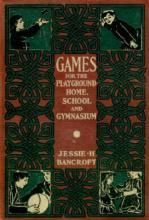
Jessie H. Bancroft wrote Games for the Playground, Home, School and Gymnasium in 1909 as a practical guide of 400 games for adult and child players in active games, quiet games, singing games, skilled athletic feats, and ball and bean bag games. He believed that “play, in games and other forms, is nature's own way of developing and training power." As (Karl) Groos impressively says, 'We do not play because we are young; we have a period of youth so that we may play.'”1
As the Assistant Director of Physical Training for New York City public schools, Jessie maintained that games develop sense perceptions, social interactions, and the training of restraint and self-control in children.2 He further noted that the games that appeal to different aged children serve their developmental needs the best. For instance, a six year old child enjoys and benefits from games with repetition, impersonation, and imagination that do not require a long attention span, great physical endurance, or many rules.3
By the time children are eight or nine years old, they are interested in more complex games that involve longer attentiveness and physical effort, individual initiatives and risks, neuro-muscular ball skills and dodging, and a natural banding together of groups who taunt each other with “nominies,” verbal defiant rhymes.4 Later these children, now aged eleven or twelve, seek more strenuous activities and team play which necessitates increased perceptive abilities in changing circumstances, rapid reactions, and quick judgments.5 At each of these stages, the play choices facilitate the child's stage of development.
In the Introduction, Jessie explored both the role of games in schools and the role of recreation among adults, while in the five ensuing chapters he provided games for all ages' developmental and recreational needs. He especially supported inter-generational games and gave examples of clubs who successfully brought children and parents together for play.
Jessie maintained that in schools even “five minutes of lively competition, of laughter, and of absorbing involuntary interest” will remedy the “nervous strain for both pupil and teacher, the need for vigorous stimulation of respiration and circulation, for an outlet for the repressed social and emotional nature, for the correction of posture, and for a change from abstract academic interests.”6 He lamented that the school recess, though, “is a sad apology for such complete refreshment of body and mind.”7 The remedy he recommended is an organized recess involving “lively games,” many of which are outlined in the book's later chapters.
While Jessie applauded the movement to provide public playgrounds for children in the city, he also noted that country children, who have the space to play, still need guidance and organization to stimulate play. In fact, he maintained they have the greater need for guidance as they have less “instincts for social combination” than the city children.8 He also addressed the physical and moral needs of both the poor and wealthy children to have fresh air, sunshine, exercise, a morally acceptable means of energy expenditure, and the “free laughter and frolic of childhood.”9
Concerning adults, Jessie declared that “As a nation we are slow to learn the value of recreation. We go to the extremes of using it either not at all or so excessively as to exhaust nervous energy to the point where 'the day we most need a holiday is the day after a holiday.'”10 For the physical laborer and “brain worker” alike, Jessie suggested the value of “short intervals of complete relaxation” and included the suggestion for work breaks and games for after hours recreation at house parties and country clubs.
Games for the Playground, Home, School and Gymnasium was the result of the author's personal experience of teaching and supervising games as well as bibliographical research of printed sources of games, folklore, and sports. Jessie's original research involved the diverse foreign population of New York City “where practically the entire world is accessible.”11
Drawing on a large pool of games from diverse cultures, he chose only games that had “strong playing values” which he organized into the chapters: To the Teacher of Games; Counting-Out, Choosing Sides, Who's “It”; Miscellaneous Active Games; Quiet Games; Feats and Forfeits; Singing Games; and Balls and Bean Bags.12 Each chapter alphabetically lists the appropriate game with its name, number of players involved, location of play, rules, diagrams, explanations, and comments. Occasionally there are photographs and always there are musical scores for the singing games.
To complete this ready reference, he indexed the games in separate indexes for elementary schools, high schools, playgrounds and large number situations, summer camps, homes and clubs, children's parties, and seashore recreation. The index for the schools doubled as a graded course, being organized according to grade levels. The reference ended with a complete alphabetical index of all the games.
- 1. Bancroft, Jessie H. Games for the Playground, Home, school and Gymnasium. New York: The MacMillan Company, 1923. p. 15.
- 2. Op.cit., pp. 10-12.
- 3. Op.cit., pp. 12-13.
- 4. Op.cit., p. 13.
- 5. Op.cit., pp. 13-14.
- 6. Op.cit., p. 17.
- 7. Ibid.
- 8. Op.cit., p. 21.
- 9. Op.cit., pp. 18-19.
- 10. Op.cit., p. 19.
- 11. Op.cit., p. 4.
- 12. Op.cit., “Table of Contents.”

